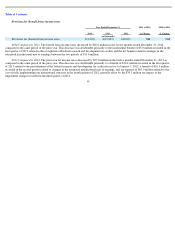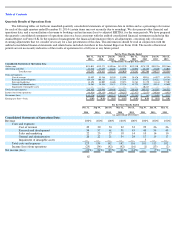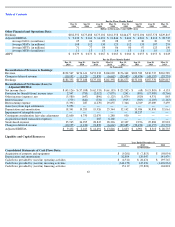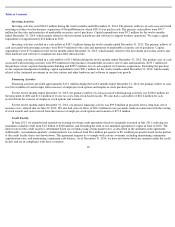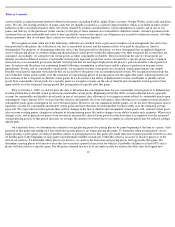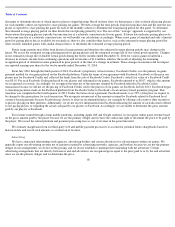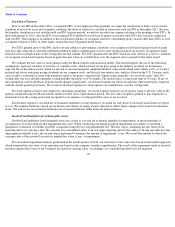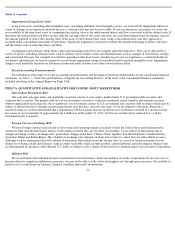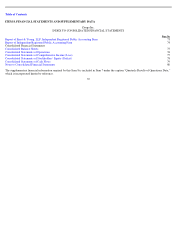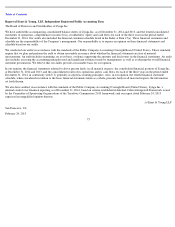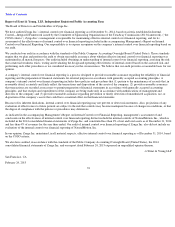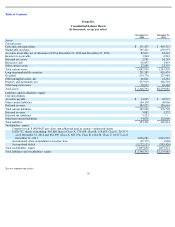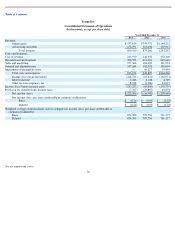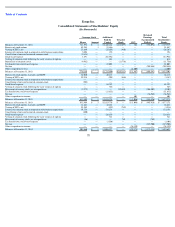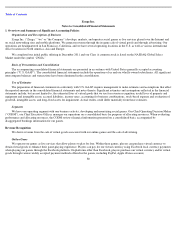Zynga 2014 Annual Report Download - page 74
Download and view the complete annual report
Please find page 74 of the 2014 Zynga annual report below. You can navigate through the pages in the report by either clicking on the pages listed below, or by using the keyword search tool below to find specific information within the annual report.
Table of Contents
Impairment of Long-Lived Assets
Long-lived assets, including other intangible assets (excluding indefinite-lived intangible assets), are reviewed for impairment whenever
events or changes in circumstances indicate an asset’s carrying value may not be recoverable. If such circumstances are present, we assess the
recoverability of the long-
lived assets by comparing the carrying value to the undiscounted future cash flows associated with the related assets. If
the future net undiscounted cash flows are less than the carrying value of the assets, the assets are considered impaired and an expense, equal to
the amount required to reduce the carrying value of the assets to the estimated fair value, using a discounted future cash flow approach, is
recorded in the consolidated statements of operations. Significant judgment is required to estimate the amount and timing of future cash flows
and the relative risk of achieving those cash flows.
Assumptions and estimates about future values and remaining useful lives are complex and often subjective. They can be affected by a
variety of factors, including external factors such as industry and economic trends, and internal factors such as changes in our business strategy
and our internal forecasts. For example, if our future operating results do not meet current forecasts or if we experience a continued decline in
our market capitalization, we may be required to record future impairment charges for goodwill and/or acquired intangible assets. Impairment
charges could materially decrease our future net income and result in lower asset values on our balance sheet.
Recent Accounting Pronouncements
For information with respect to recent accounting pronouncements and the impact of these pronouncements on our consolidated financial
statements, see Note 1—“Overview and Summary of Significant Accounting Policies” in the notes to the consolidated financial statements
included elsewhere in this Annual Report on Form 10-K.
ITEM 7A. QUANTITATIVE AND QUALITATIVE DISCLOSURE ABOUT MARKET RISK
Interest Rate Fluctuation Risk
Our cash and cash equivalents and marketable securities consist of cash, money market funds, U.S. government debt securities and
corporate debt securities. The primary objective of our investment activities is to preserve principal, ensure liquidity and maximize income
without significantly increasing risk. Our available-for-sale investments consist of U.S. government and corporate debt securities which may be
subject to market risk due to changes in prevailing interest rates that may cause the fair values of our investments to fluctuate. Based on a
sensitivity analysis, we have determined that a hypothetical 100 basis points increase in interest rates would have resulted in a decrease in the
fair values of our investments of approximately $6.4 million as of December 31, 2014. Such losses would only be realized if we sold the
investments prior to maturity.
Foreign Currency Exchange Risk
We have foreign currency risks related to our revenue and operating expenses incurred outside the United States and denominated in
currencies other than the functional currency of the entities in which they are recorded. Accordingly, we are subject to fluctuations due to
changes in foreign currency exchange rates, particularly changes in the Euro, Chinese Yuan, Japanese Yen, British Pound, Canadian Dollar,
Australian Dollar and Indian Rupee. The volatility of exchange rates depends on many factors that we cannot forecast with reliable accuracy.
Although we have experienced and will continue to experience fluctuations in our net income (loss) as a result of transaction gains (losses)
related to revaluing certain cash balances, trade accounts receivable, trade accounts payable, current liabilities and intercompany balances that
are denominated in currencies other than the U.S. dollar, we believe such a change would not have a material impact on our results of operations.
Inflation Risk
We do not believe that inflation has had a material effect on our business, financial condition or results of operations. If our costs were to
become subject to significant inflationary pressures, we may not be able to fully offset such higher costs through price increases. Our inability or
failure to do so could harm our business, financial condition and results of operations.
71


